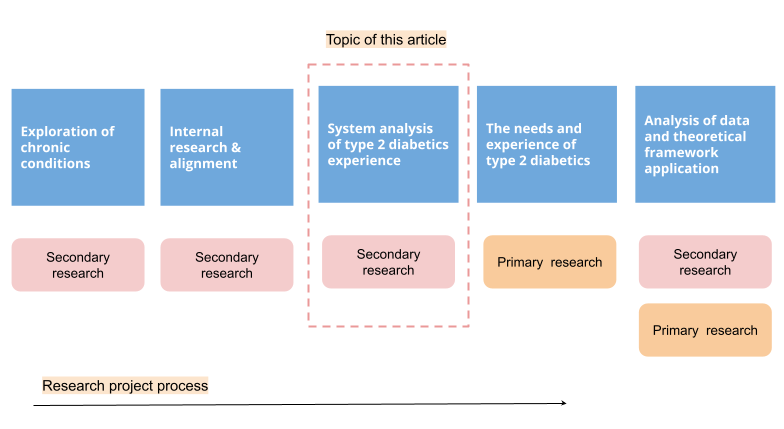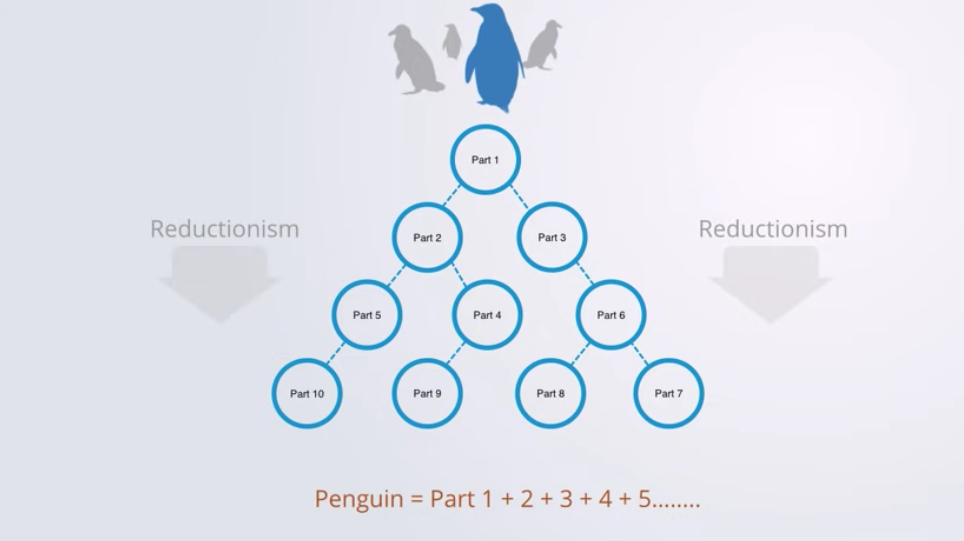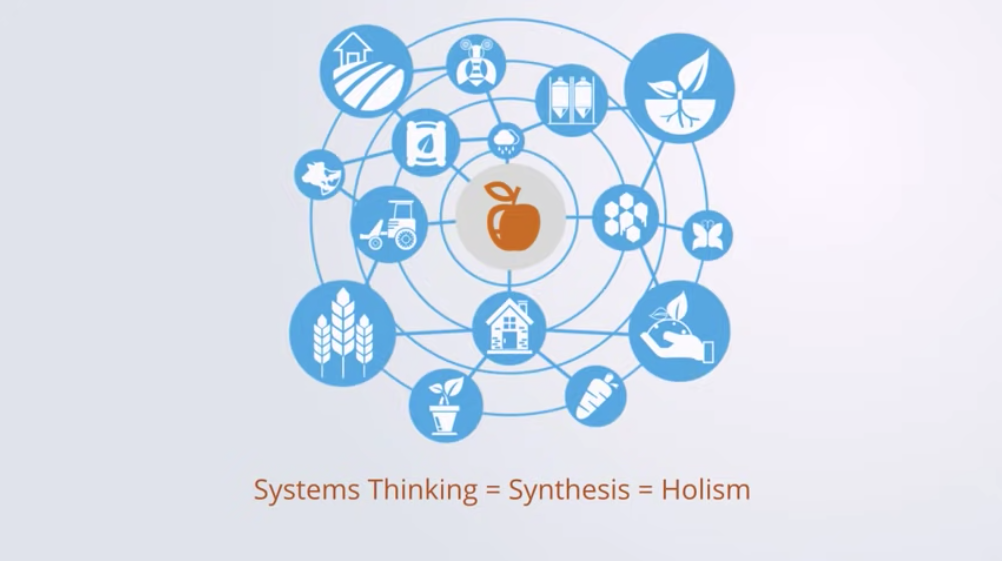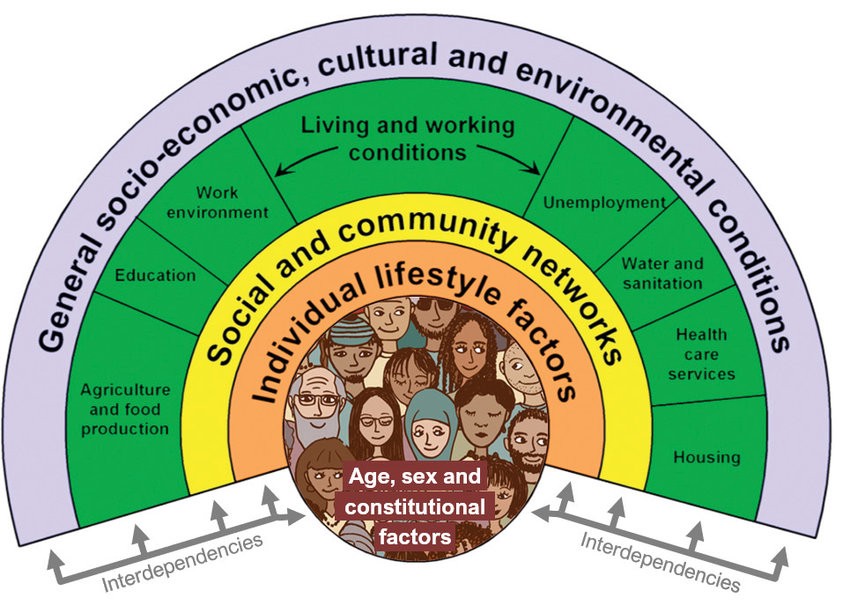The purpose of this series is to help you leverage secondary research in your applied research practice. In the first article, I called out how secondary research is chronically underused in tech and explained why it is imperative we make better use of it. In this article, I will focus on how systems thinking can help us scope our secondary research for both scale and depth using a health-tech case study.
While Primary user research at the scale used in most tech companies can answer questions about users’ attitudes and behaviors, secondary research reveals the world in which our current or future users live. We have a tendency to call this “context” but we can also refer to it as “system.” Without a clear view of this system, we end up with a shallow understanding of user challenges which may lead us to solve the wrong problems.
Case study intro: Understanding type-2 diabetics
Recently I conducted a project on the experience of patients with type-2 diabetes. Given the industry nature of this case study, I will only be able to provide a high-level description of methodology rather than specific insights.
The purpose of the project was to gain an understanding of patients’ needs and experiences when it comes to managing their diabetes across different healthcare systems. I led this research with the help of two talented researchers who executed the primary research we later conducted. We sought to identify common challenges and gaps that could be addressed through new or existing healthcare products.
One of the reasons I selected this case study is because its foundational nature called for a mixed-method approach that incorporated secondary research throughout.

Systems thinking 101
There are two main paradigms in science: analysis and synthesis. A paradigm is essentially a worldview that makes up the assumptions and methods we use to form theories.
In the analysis paradigm, we use reductionism to explain an object or phenomenon. For example, if we wanted to understand how a car functions, the reductionist approach would first analyze the separate components of a car such as a powertrain, brakes, and electrical system, and explain how each of these works independently. With analysis, we understand the whole as the sum of its parts. This paradigm does not, however, explain the relationship between the components and therefore is not ideal when trying to understand highly complex systems with many interdependencies and relationships between components.

In contrast, the synthesis paradigm views the object as a part of a connected whole. In other words, the system is defined by the connections and relationships between its elements. This paradigm is far more compatible with the inherent complexity and interconnectedness of health and healthcare systems. A healthcare consumer, unlike a commercial one, is also constrained and affected by the system: a patient generally has limited agency.

When we synthesize information (aka practice systems thinking) we usually:
- identify the system that our object of interest is a part of,
- identify and assess how the elements of the system function independently (aka analysis),
- and finally, explore how these elements interconnect and relate to form the context around our object.
Applying systems thinking to our case study
We followed a very similar process in our project. We started by identifying the systems that patients belong to, then explored the different elements in those systems and how they worked, and finally fleshed out the relationships and interdependencies among those elements in each system.
To save time we started with an outline of research questions for each system and its elements which informed our secondary and primary research. Below is a high-level view of 2 of the systems we looked at.
System 1: The health care system
As a part of this project, we looked into different elements of the three healthcare systems we explored. True to systems thinking, we sought to understand the individual components of how these systems function when it comes to caring for diabetic patients, but also how these components relate to each other and hence affect the patient.
We used a combination of secondary resources such as official sites by government and healthcare authorities, previous research and analysis from academics and officials, as well as our own primary research. We interviewed 30 patients from 3 different countries. Here are some of the questions we answered about healthcare systems in our research:
- How do these healthcare systems practice diagnosis, treatment, and long-term management of diabetes?
- What does the patients’ healthcare team look like and what roles do they play (doctor, nurse, dietitian, etc)?
- What is the role of the patient in managing their care in each of these systems? What level of agency do they have?
- What kinds of support do patients get to manage their care?
- What are the main challenges (practical, emotional, or otherwise) for patients and healthcare providers within these systems?
By utilizing both secondary and primary research to answer these questions we were able to get a more complete picture of how healthcare systems operate, how patients experience their care, and the systemic reasons (interconnection of factors) that create the reality for patients.
System 2: The patient’s system biology
System biology applies systems thinking to human health by looking into the genetic, environmental, and situational elements that impact it. Conducting secondary research on this system helped us understand other factors that contribute to or are detrimental to improving or managing one’s health. With a systems model in hand, we could identify the right problems to solve for users.

Here too we relied on a combination of secondary resources such as public health policy papers, research done by think tanks focused on the future of healthcare, past studies on human health, and type-2 diabetes studies of our target population. We also asked our own research participants questions that informed our understanding of their individual system biologies. Here are some of the questions we answered about system biologies in our research:
- What does it mean to be healthy or well when one has a chronic condition? How do patients and healthcare professionals view it?
- What are the personal, biological, and environmental conditions that facilitate better habits and disease management for diabetes patients?
- What are the impediments to improving or managing their health and condition?
- What roles do income, mental health, family status, and education level play in managing diabetes?
Due to system-biology complexity, we really leaned in on secondary research to frame and understand the different elements within it. The combination of primary and secondary research on this topic helped us view the challenges of patients and healthcare providers in a greater context of human health. This helped us identify an impactful product direction for a broader and more diverse set of patients.
Finding the right product goal
A common challenge with open-ended 0-to-1 product exploration is how we choose to scope what to research. If we apply primary research methodologies without expanding our understanding of the systems that affect the problem space, we risk oversimplifying or worse, creating solutions that fail to address the root causes for the problems at hand. Take a second look at the research questions we covered under each system and ask yourself if we would have been able to answer (or even ask) these questions if we relied solely on primary user research.
When we build products that aim to address or improve human lives, we must have clear product goals. In health tech, product goals range from making people healthier (improving actual health metrics), making the experience of managing health conditions easier (the usability of healthcare), and improving patient quality of life. Picking the right goal, in this case, depends not only on our knowledge of patients’ attitudes and behaviors (the data generally collected by traditional user research) but also on a clear view of the worlds that affect our users.
Try and use system thinking to scope your secondary research in your next project. I am positive you will uncover game-changing insights!






